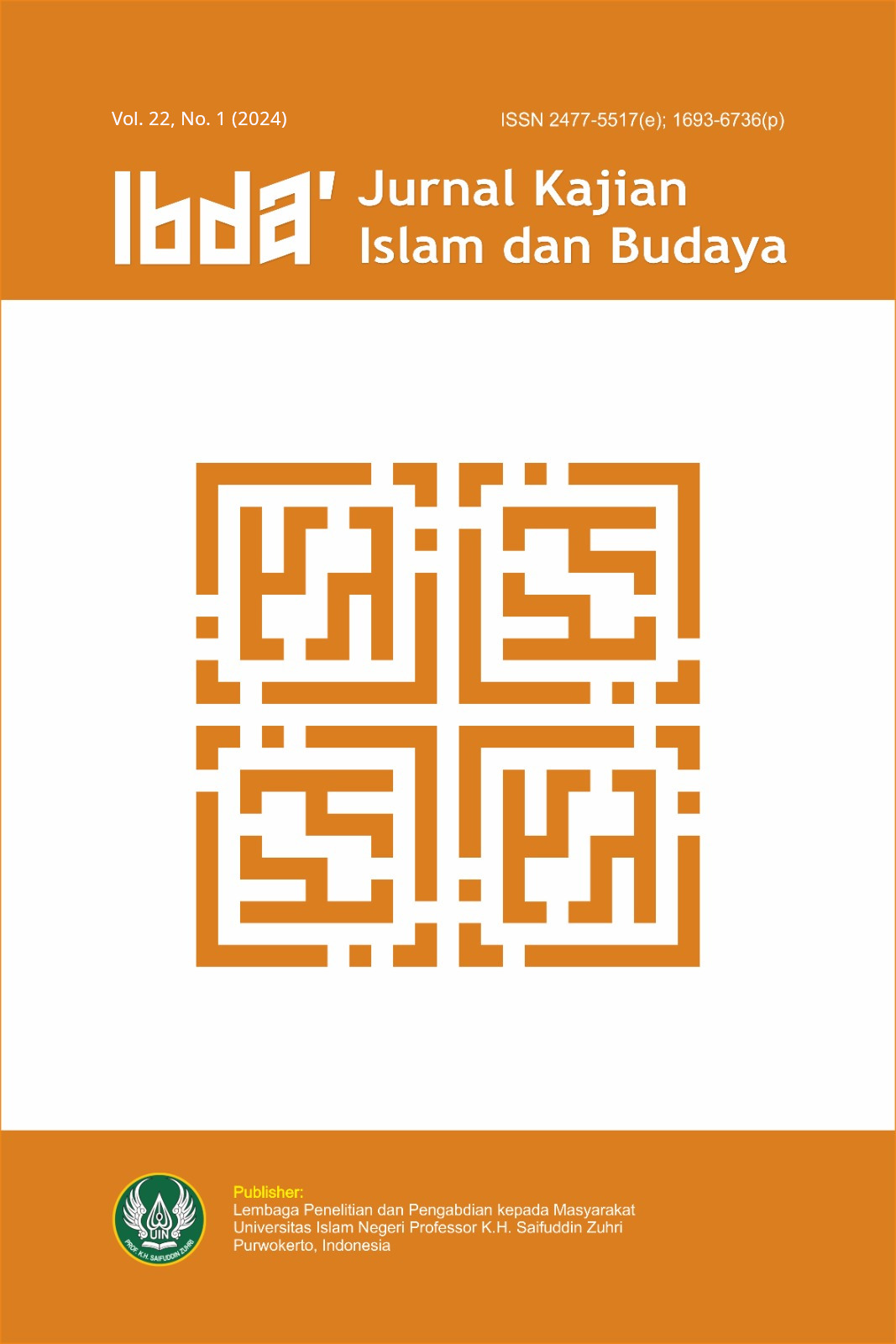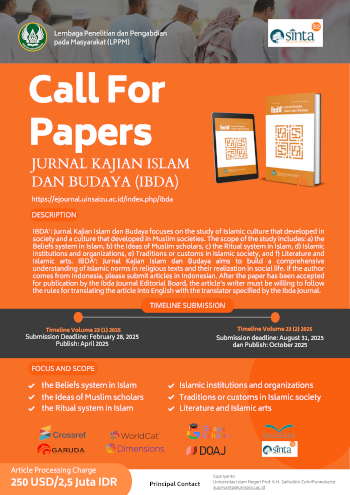Legal Protection for Women and Children in the Marriage Tradition of Muslim Communities
DOI:
https://doi.org/10.24090/ibda.v22i1.9681Kata Kunci:
legal protection, marriage tradition, muslim community, women and childrenAbstrak
The Muslim community in East Java has a tradition of marriage that is believed to be a virtue. The tradition of marriage must provide legal protection for women and children. This study aims to (1) analyze the legal culture in the marriage tradition of the Muslim community in East Java and (2) find a model of preventive legal protection for women and children in the marriage tradition of the Muslim community in East Java. This research method is sociological research, which is expressed in quantitative data. Based on the research results, it is known that preventive legal protection for the Muslim community in East Java can be done by making the dowry an economic guarantee, providing monthly money, and the need for a prenuptial agreement. The Muslim marriage tradition in East Java typically sees wives joining their husbands' homes or establishing a shared residence, leading to a customary practice where wives may return to their own families upon divorce despite contributing to jointly owned homes. To address the economic vulnerabilities women and children face post-divorce, legal provisions should include stipulations on marriage dowry amounts, monthly financial obligations for wives, and requirements for prenuptial agreements to safeguard their interests. Implementing such protections would mitigate the financial repercussions experienced by wives and children following divorce.Unduhan
Referensi
Aziz, S. (2017). Tradisi Pernikahan Adat Jawa Keraton Membentuk Keluarga Sakinah. IBDA: Jurnal Kajian Islam dan Budaya, 15(1), 22–41.
Damsuki, A. (2019). Konsep Pernikahan Masyarakat Samin dan Pendekatan Dakwah Kultural. Islamic Communication Journal, 4(1), 102–118.
Febbrajo, A. (2018). Law, Legal Culture and Society: Mirrored Identities of the Legal Order. Taylor & Francis.
Feeley, M. M., & Miyazawa, S. (2011). Legal Culture and the State in Modern Japan. Dalam R. W. Gordon & M. J. Horwitz (Ed.), Law, Society, and History (hlm. 169–188). Cambridge University Press. https://doi.org/10.1017/CBO9780511921629.012
Friedman, L. M. (1969). Legal Culture and Social Development. Law & Society Review, 4(1), 29–44. JSTOR. https://doi.org/10.2307/3052760
Friedman, L. M. (1994). Is There a Modern Legal Culture? Ratio Juris, 7(2), 117–131. https://doi.org/10.1111/j.1467-9337.1994.tb00172.x
Galistya, T. M. (2020). Kekerasan terhadap Perempuan dan Perceraian dalam Perspektif Pemberdayaan Perempuan. Jurnal Dinamika Sosial Budaya, 21(1), Article 1. https://doi.org/10.26623/jdsb.v21i1.1500
Kominfo Jatim. (2020). Kasus Kekerasan Perempuan dan Anak di Jatim Masih Tinggi | Dinas Komunikasi dan Informatika Provinsi Jawa Timur. http://kominfo.jatimprov.go.id/read/umum/kasus-kekerasan-perempuan-dan-anak-di-jatim-masih-tinggi
Kurniawati, P. I., Dinastiti, C., Ningtias, Y. K., Khoiriyah, S., & Putri, N. A. (2012). Potret Sistem Perkawinan Masyarakat Tengger di Tengah Modernitas Industri Pariwisata. Solidarity: Journal of Education, Society and Culture, 1(1), Article 1. https://journal.unnes.ac.id/sju/index.php/solidarity/article/view/215
Listyana, R., & Hartono, Y. (2015). Persepsi dan Sikap Masyarakat terhadap Penanggalan Jawa dalam Penentuan Waktu Pernikahan (Studi Kasus Desa Jonggrang Kecamatan Barat Kabupaten Magetan Tahun 2013). AGASTYA: JURNAL SEJARAH DAN PEMBELAJARANNYA, 5(01), Article 01. https://doi.org/10.25273/ajsp.v5i01.898
Mardhatillah, M. (2014). Perempuan Madura sebagai Simbol Prestise dan Pelaku Tradisi Perjodohan. Musãwa Jurnal Studi Gender Dan Islam, 13(2), Article 2. https://doi.org/10.14421/musawa.2014.132.167-178
Muntamah, A. L., Latifiani, D., & Arifin, R. (2019). Pernikahan Dini di Indonesia: Faktor dan Peran Pemerintah (Perspektif Penegakan dan Perlindungan Hukum Bagi Anak). Widya Yuridika: Jurnal Hukum, 2(1), Article 1. https://doi.org/10.31328/wy.v2i1.823
Nelken, D. (2014). Thinking About Legal Culture. Asian Journal of Law and Society, 1(02), 255–274. https://doi.org/10.1017/als.2014.15
Nugraha, X., Izzaty, R., & Putri, A. A. (2019). Rekonstruksi Batas Usia Minimal Perkawinan Sebagai Bentuk Perlindungan Hukum terhadap Perempuan (Analisa Putusan MK No. 22/Puu-Xv/2017). Lex Scientia Law Review, 3(1), Article 1. https://doi.org/10.15294/lesrev.v3i1.30727
Rahmadani, N. F., & Farhany, G. (2019). Proses Komunikasi dalam Pernikahan Etnis Madura. Jurnal Interaksi : Jurnal Ilmu Komunikasi, 3(2), Article 2. https://doi.org/10.30596/interaksi.v3i2.3353
Rofikoh, S. (2018). Strategi Masyarakat Suku Osing dalam Melestarikan Adat Istiadat Pernikahan di Tengah Modernisasi: Studi Kasus di Desa Kemiren Kecamatan Glagah Kabupaten Banyuwangi [Undergraduate, UIN Sunan Ampel Surabaya]. http://digilib.uinsby.ac.id/24655/
Rohman, F. (2015). Makna Filosofi Tradisi Upacara Perkawinan Adat Jawa Kraton Surakarta dan Yogyakarta (Studi Komparasi) [Undergraduate, UIN Walisongo]. http://eprints.walisongo.ac.id/4537/
Toharia, J. J. (2011). Exploring Legal Culture. Dalam R. W. Gordon & M. J. Horwitz (Ed.), Law, Society, and History (hlm. 90–100). Cambridge University Press. https://doi.org/10.1017/CBO9780511921629.007
Wagianto, R. (2017). Tradisi Kawin Colong pada Masyarakat Osing Banyuwangi Perspektif Sosiologi Hukum Islam. Al-Ahwal: Jurnal Hukum Keluarga Islam, 10(1), Article 1. https://doi.org/10.14421/ahwal.2017.10106
Wakhyuningsih, S. (2009). Nilai-Nilai Moral pada Upacara Perkawinan Adat Walagara Masyarakat Suku Tengger di Desa Jetak Kecamatan Sukapura Kabupaten Probolinggo [Diploma, Universitas Negeri Malang]. http://repository.um.ac.id/51381/
Unduhan
Diterbitkan
Cara Mengutip
Terbitan
Bagian
Lisensi
Hak Cipta (c) 2024 Sudirman, Intan Suria Hamzah

Artikel ini berlisensiCreative Commons Attribution-ShareAlike 4.0 International License.
Authors who publish with this journal agree to the following terms:
- Authors retain copyright and grant the journal right of first publication with the work simultaneously licensed under a Creative Commons Attribution-ShareAlike License a that allows others to share the work with an acknowledgement of the work's authorship and initial publication in this journal.
- Authors are able to enter into separate, additional contractual arrangements for the non-exclusive distribution of the journal's published version of the work (e.g., post it to an institutional repository or publish it in a book), with an acknowledgment of its initial publication in this journal.
- Authors are permitted and encouraged to post their work online (e.g., in institutional repositories or on their website) before and during the submission process, as it can lead to productive exchanges, as well as earlier and greater citation of published work (See The Effect of Open Access).
















